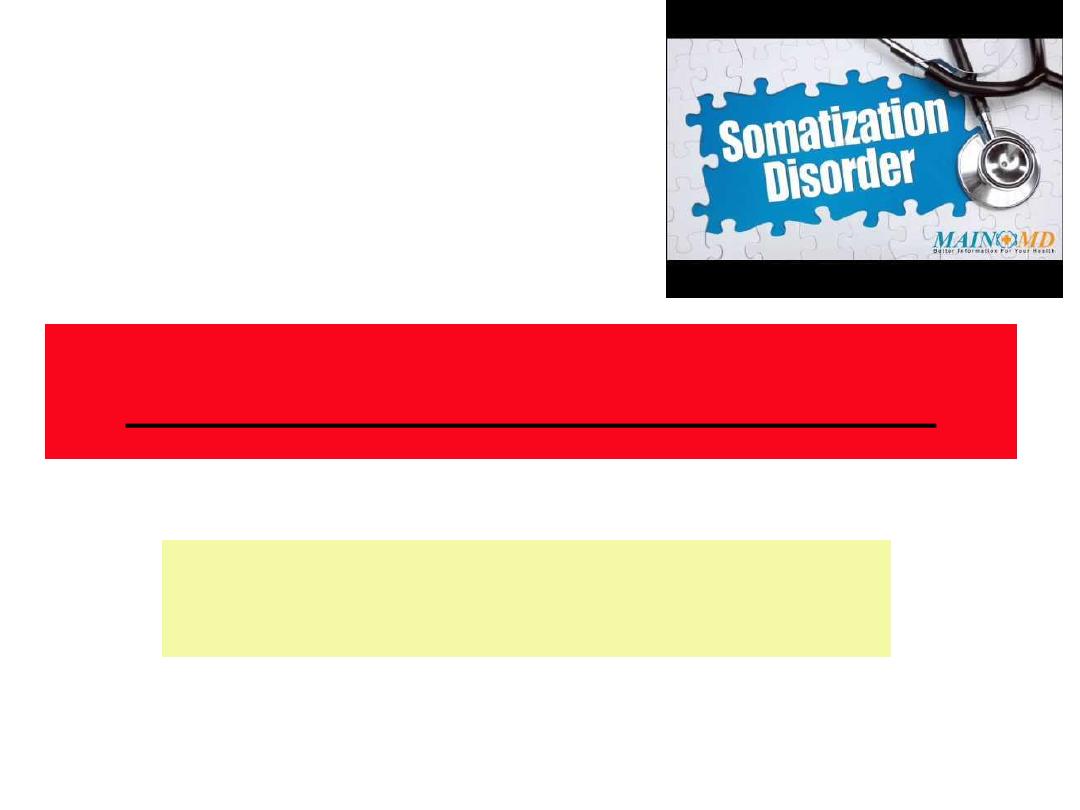
The Somatizing Patient
Dr. Zaid M. Yassen
Family medicine
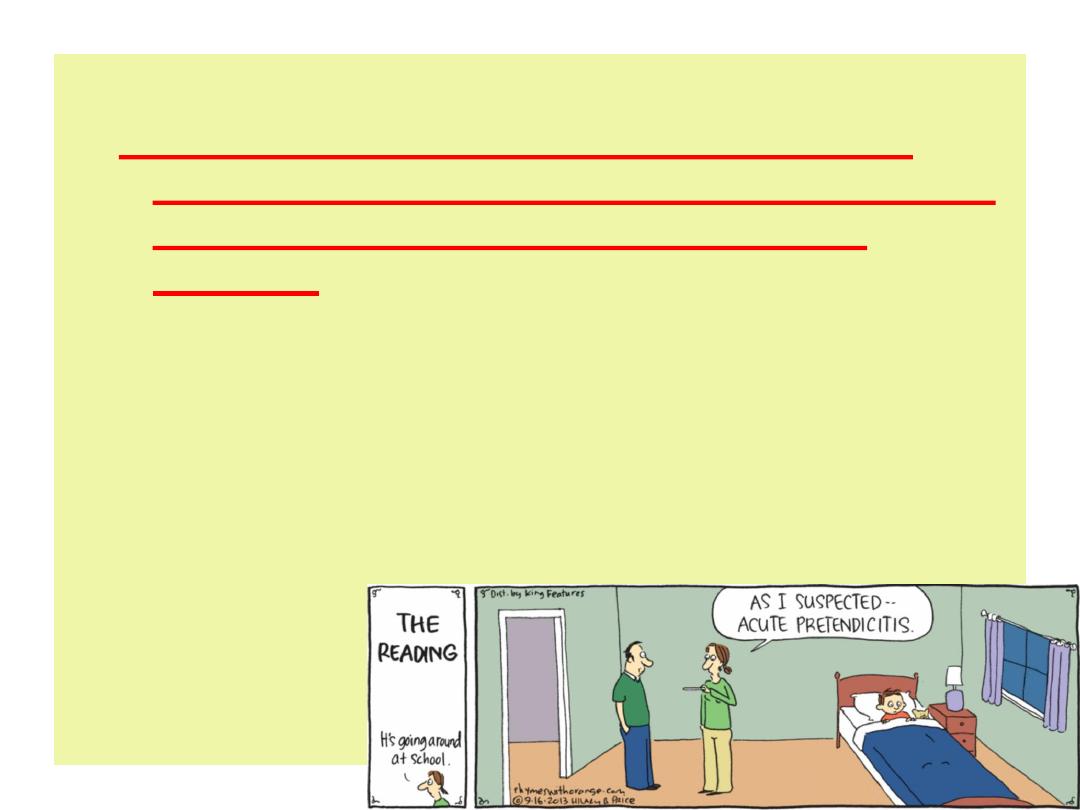
The somatizing patient has one or more
physical complaints for which appropriate
medical evaluation finds no organic
disease.
When there is documented pathology but the
symptoms or impairment grossly exceeds
what would be expected from the physical
findings.
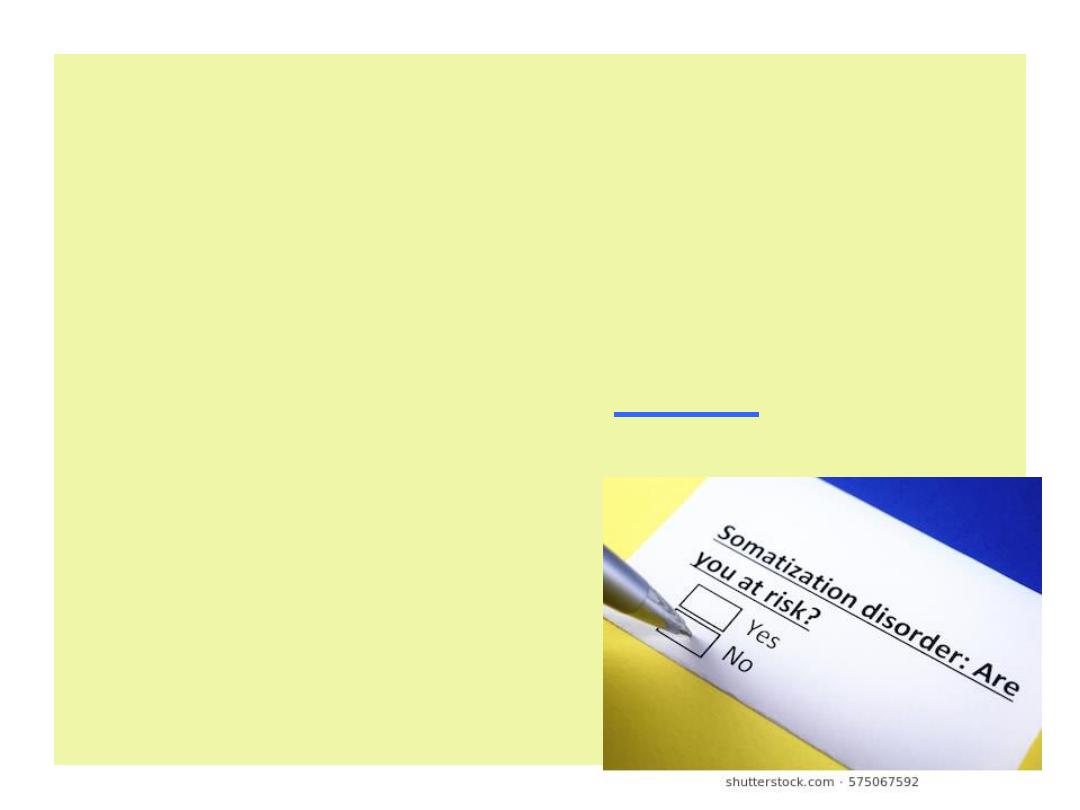
Somatization is a tendency of patient to create
physical symptoms out of emotional
responses.
Somatization accounts for 10-30% of all visits to
primary care physicians.

– Somatic symptoms form a continuum from
mild to severe & from bothersome to
incapacitating.
– Somatization may be primary or secondary to
other illness.
– Up to 30% patient subsequently develop an
illness that may be related to their symptoms.

Many of these patients receive unhelpful or
iatrogenically dangerous evaluation or
treatment that fails to address the underlying
problem.
– Rapid & persistent symptoms resolution is
unlikely to happen with the somatizing patient.
– Attention to the patient – physician
relationship is crucial in caring for these
patients.
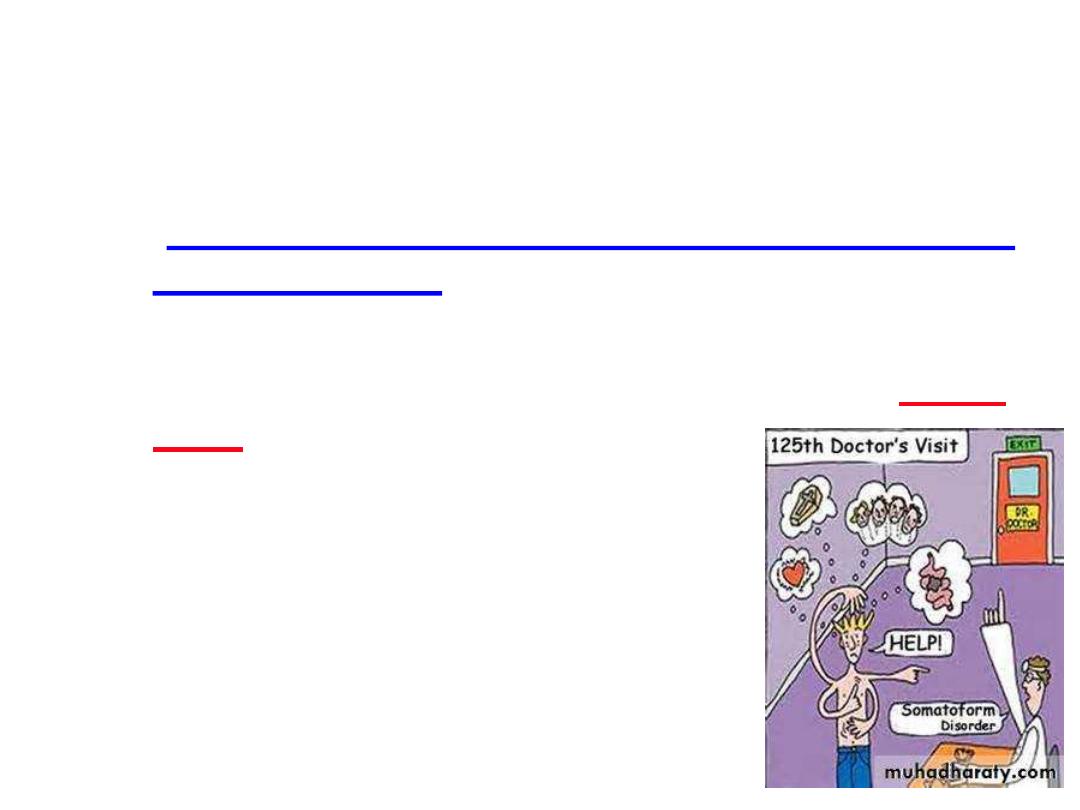
– Somatization can be aided by doctors
persistently trying to create a disease out of a
mass complaints.
– (A disease created in a patient mind is very
hard to dispel)
.
– These patients are difficult & labeled as Heart
Sing patients.

• Prevalence
– 25-75% of patients visit primary care physicians
involve psychogenic precipitants rather than medical
problems.
– Only 16% of new symptoms complaints in an internal
medicine practice had an identifiable physical cause.
– Demonstrable organic cause can be identified for less
than 25% of the 8 common complaints
(Fatigue,
back pain, headache, dizziness, chest pain,
dyspnea, abdominal pain and anxiety).
-
10-20% of medical budget is spent on patients who
somatize or have hypochondriacal concerns
.

• Pathophysiology:
Possible amplification of normal bodily
sensation, genetic causes, psychological
causes.
Chronicity is important diagnostic criteria
.

Clinical Presentation:
• Presents with a history of recurrent multiple
physical complaints of several years duration
beginning before the age of 30 years.
• The description of the symptoms may often be
vague but the presentation is often dramatic.

1. Conversion symptoms e.g. paralysis, seizures, loss of
voice, stiffness, fainting, difficult in swallowing.
2. Menstrual symptoms e.g. pain, irregularity, excessive
bleeding.
3. Gastro-intestinal symptoms e.g. nausea, vomiting, pain,
diarrhea, bloating, food intolerance.
4. Pain usually ill-defined in various joints, back,
extremities.

5. Psychosexual symptoms e.g. lack of sexual drive, pain
during intercourse.
6. Cardio-pulmonary symptoms e.g. short of breath,
palpitation, chest pain, dizziness.
Remember that these symptoms are real to the
patient.

Evaluation:
• A thorough relevant history & physical
examination is important.
• Neither the presence of a physical exam
Abnormality nor a history suggestive of a
physical illness eliminates the possibility of
somatization.

Remember that:
1) The patient is as frightened as you are.
2) The patient thinks it is more serious than you
do.
3) Illness is frightening but understanding what is
going on helps, this applies to the patient and to
you.
4) Taking a history is a method of controlling what
the patient says.
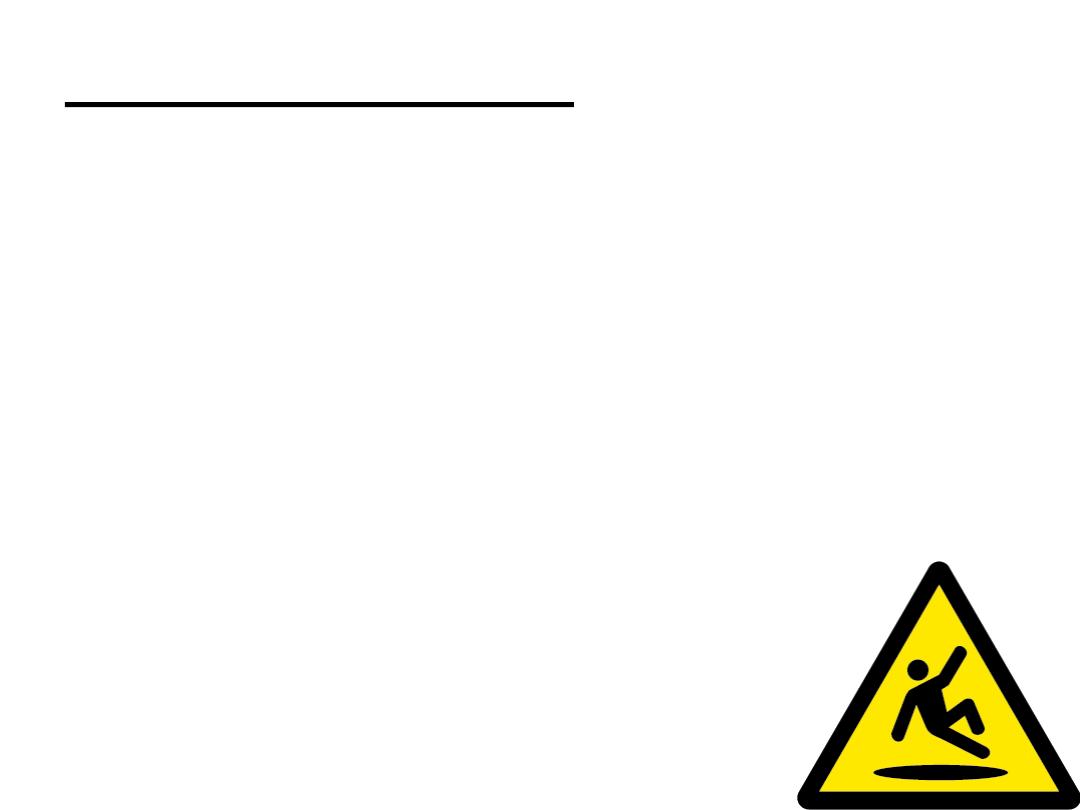
Differential Diagnosis:
• The assessment should be aimed at ruling
in the most probable causes of the
observed problems rather than making an
exhaustive attempt to rule out all the often
unlikely possibilities.
• There are pitfalls associated with both
over-diagnosis and under-diagnosis of
somatization.

Differential Diagnosis:
• Over-diagnosis of somatization may result in
failure to identify and treat other illnesses there
by increasing morbidity and mortality.
• Failure to make the diagnosis of somatization
may result in excessive diagnostic test,
unnecessary costs and iatrogenic reinforcement
of the patient belief that is undetected underlying
physical illness remains.

Management:
• The somatizing patient in primary care is a challenge for
the physician in many ways.
• Making an accurate diagnosis, understanding the patient
and helping patient feel understood are essential to an
effective treatment plan.
• These patients often develop a keen sense of not being
treated correctly.
• If the patient senses that the physician is attempting to
get rid of him, symptoms generally worsen which may
lead to doctor shopping and more tests.

• Accurate Diagnosis includes a biopsychosocial
understanding of the patient.
• It is Important to help patient to understand the
disorder & its symptoms & only after this process
begins the patient will begin to attribute the
symptoms to the correct cause.
This process begins slowly over many visits
*
The indiscriminate use of multiple medications to
treat symptoms usually has a paradoxical effect.

• Some Rx involve brief periods of medication,
reassurance & education. They benefit from
medical assessment coupled with cognitive &
behavioral therapy in the context of a healing
doctor patient relationship.
• Remember that offering honest, clear, sincere
reassurance and education is a mainstay of
medical care.

Strategies for decreasing patient tendency
to become somatically fixated & medically
dependent:
1. Appropriate communication skills with
particular emphasis on achieving a shared
understanding, shared management plan.

2. Use the traditional disease-based medical
model with care.
Good efficient clinical practice demands
balances (most headaches do not warrant
CT scans).
(Investigations on demand are bad
medicine, Rx on demand may be worse).

3) Avoid referral if at all possible.
* Only when there is a reasonable Diagnosis
referral should be made.
Hospital medicine is almost exclusively disease
based, patient must be diagnosed thoroughly
and possible causes ruled out.
Referrals should only be made for:
a) Diagnostic reasons.
b) Therapeutic purposes.
c) For reassurance.

4)
Try to keep the number of doctors involved with a
patient to a minimum. The more doctors the more
somatization.
5)
Keep good records. The SOAP system has merit
(subjective, objective, assessment & plan).
6)
Communicate with your colleagues about patient you
suspect of undue somatization.
7)
Write explicit & detailed referral letters.
8) Use patient diaries & other methods of self-recording
to try to produce more insight & linkage between
events & symptoms.

The following Cues should alert the physician to the
possibility that he should be working in the personal
& interpersonal rather than in the clinical
–
pathological context
1) Frequent attendances with minor illnesses.
2) Frequent attendances with same symptoms or with
multiple complaints.
3) Attendance with symptoms that has been present for
along time.
4) Attendance with a chronic disease that does not appear
to have changed.
5) Incongruenty between the patient distress and the
comparatively minor nature of symptoms

6) Failure to recover in the expected time from illness,
injury or operation.
7) Failure of reassurances to satisfy the patient.
8) Frequent visits by a parent with a child with minor
problems.
9) An adult patient with an accompanying relatives.
10) inability to make sense of the presenting problems.

The Difficult Patient
1) Patients who have developed a somatic
fixation.
2) Patients who abuse themselves with drugs or
alcohol.
3) Patients who have become dependent on
prescription drugs.

4) Patients who make excessive demands on us
by frequent visits, out of hours visits, pressure
for tests, medication or referrals.
5) Patients who move from doctor to doctor.
6) Angry patients.
